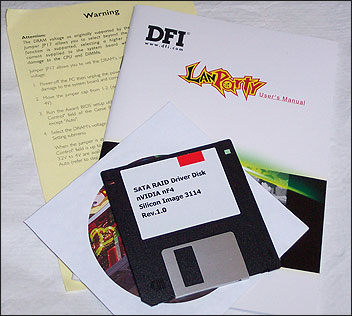DFI LanParty UT nF4 SLI-D - Bundle, Presentation and Manuals
Presentation
I had a conversation with someone recently about DFI boards being used by large system builders and why that's not quite happened as yet. The suggestion was made that DFI's presentation and obvious gamer bent for their LanParty and LanParty UT boards is maybe the reason why. DFI obviously go after a very specific niche market with the LanParty and LanParty UT series of boards, and while they have the Infinity series for the boards with more plain presentation and no UV-reactive components on the boards, there's currently no Infinity nForce4 product.
That's not to say a knowledgeable buyer for a large system builder won't know that the LanParty UT boards are worth looking at, regardless of looks or packaging, but it may be a reason. For me, I'd rather give the queer packaging a big miss (and not so that it can be replaced by busty robotic 'babes' or other such drivel) and have DFI tone it down and let the mainboard do the talking. "UV on, Tweak fun!!". Quite.
Bundle
You don't get the same plentiful bundle that ASUS give you with their Deluxe SLI board, with the DFI SLI-D. That's not to say there's bugger all, though.As you can see, you get a chip removal tool, bags of extra jumpers (both normal and the type required for the memory voltage and SLI mode adjust functions), the ATX I/O shield, the inter-GPU connector, SATA cables (only 2), a pair of rounded (and custard-esque) PATA cables, a rounded floppy cable and a solitary Molex-to-2 SATA power splitter. I'd like to see board makers offer a data cable count to match the number of ports available on boards, since SATA cables are overpriced by online vendors, even more so by bricks and mortar stores and drives are rarely bundled with them.
Manual and CDs
The manual is fairly light on information and I actually suspect I'm missing the main one that goes into things in more detail. Indeed, [H]ard|OCP's review of the -DR shows more manuals than I have here.
The CD has all the drivers you'll need, along with nTune for tweaking the mainboard and there seems to be a CMOS Reloaded manual to show you the ins and outs of that part of the DFI's BIOS. Which leads me on nicely to that part of the examination. The following page is very image heavy, for those on dialup.













